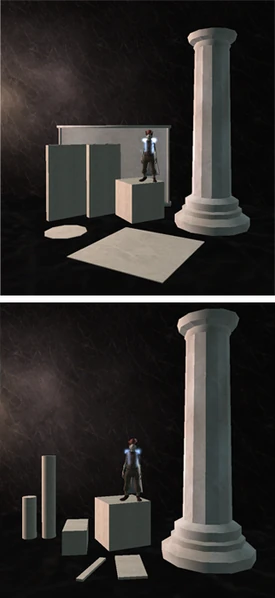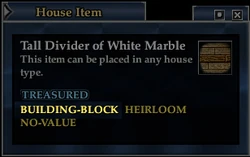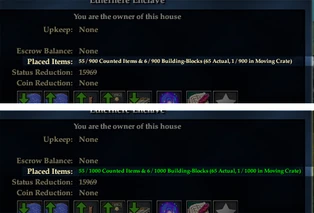Housing Item Limit refers to the number of items that can be placed in any home owned by a character. Building blocks are a type of house item that comes in a variety of shapes, intended to encourage players to build unique structures or items with them.
- For the sake of simplicity, "house" used within this context refers to any type of housing or guild hall.
- When the term "item count" is used below, it refers to the total normal (furniture) items and building blocks, unless otherwise indicated.
- Like housing, guild halls have the same types of limits, but, for the sake of simplicity, it is only referred to in relationship to housing.
Overview[]

(click the image to enlarge it)
The Housing window; highlighted here: note the line for Placed Items has numbers for both "normal" items and building blocks.
Near the bottom of the window, buttons with green arrows can be used to quickly pick items up or pack them in a Moving Crate.

The Housing UI shortcut shows only inside a house. Click the House icon to open the window and see your item and building block count.
Items count is a term used to describe the item limit (the base number of items that can be added to any home owned by a character minus the number of items placed in a house while decorating that house). For example, if you have a house that starts with a 900 item limit and place one item, your item count is reduces to 899.
In the early days of the Everquest 2, both housing and the item count that limited decorating houses was pretty straightforward; houses came in a few sizes, determined by the number of rooms they had, and the number of rooms indicated an item limit.
That has changed! There are now two numbers to check that make up the count. One number refers to common house items (often generically called "furniture") while the other refers to any tiles, columns, stairs and more that are flagged with "building block".
Why Item Counts Exist[]
As much as those who love to decorate fantasize about unlimited items in a house, it does serve a purpose.
The least nerdy and most truncated way to explain it is that each item you place needs to load on the screen when you enter any space; in essence, the game program "builds" the house with all its items when anyone enters. The more unique items (unduplicated) and complex the items' structure, the harder it is for a computer to perform this task.
When the housing system was first included in the game, computers were much less powerful and over time, most players tend to have systems that can "handle" more. There are still inherent difficulties tied to the legacy of the software that will also cause a bit of a gap between what our faster computers can do. And naturally, the speed of the internet connection also radically impacts the balance of item counts vs. load times too!
Past vs. Present[]
As these facets of the game gained popularity, significant changes to housing changed how both housing and "rooms" are perceived.
- Additional rooms were added to all Standard Houses and, in 2010, large standard houses gained an outdoor balcony.
- Prestige Housing added homes of various sizes and, because many are based on playable zones within the game already and lack pre-built structures, Prestige homes lend themselves to much higher item counts and flexibility than players had seen in older housing zones.
- Even with the growth of prestige homes, the older standard housing remains very relevant due to the ease with which it can be obtained. Likewise, it can be a great pleasure to work within those spaces or even break out into the world outside their walls.
What Counts Toward the Limit?[]
Now that you understand that item limits are listed for (general) items of every kind and for building blocks, just remember that most items you place while decorating a house will count toward the limits.
- In fact, it is far easier to state what doesn't count at all. That can be summarized as:
- Most books for/from quests, including Lore and Legend books, no longer count against item limits. While it may not be a complete list, you can look for specific titles in a post on the official Daybreak forums. Player-written books do not count toward the item limit.
- In the past, items in the Moving Crate (a crate used to move from one house to another or store items) used to count against the items limit in houses, but this is no longer true. The removal of item count from the Moving Crate means it can be used to quickly move large groups of items around the house while you decorate or to stash items you want to access easily later (like holiday-themed decorations).
About Size and Room Count[]
- An editor is currently updating this section as of 1/29/16
Floor plans and room counts have changed in older cities. As a result, the old system of counting rooms is confusing at the least and completely misleading if you're looking for a house with the maximum space for decorating.
The User Interface (UI) related to housing had a significant redesign and a system called Housing & Leaderboards introduced:
- The freedom to easily "publish" (share) homes you decorate
- Visit those published by other players
- The potential to "win" house item rewards like the House Rating Trophy when published houses are well received by the decorating community.
As a result, houses are published in categories by their size, rather than a generic number of rooms or locations.
Though there are no absolute "rules" for what determines a size, especially when Prestige Housing is taken into account, it often (more) accurately indicates a relative size compared to other housing.
Room count may always be somewhat debatable, but the counts listed in the tables below list interior rooms separate from any outdoor areas.
Building Blocks[]

Examples of building blocks when placed in a house.
The distance and angle is slightly different to accommodate the (square) Tile in the top image and the (biggest) Room Divider in the back was scaled down to its smallest size. All other items are at their normal size. The ratonga standing here gives a sense of normal scale.

An example of extreme, skillful building block use by decorator, Raainy. Published on Maj'Dul under Miisty as "Perfectly Ridiculous Sanctuary". The entire space has been covered with building blocks. Click to see full size.

Perfectly Ridiculous Sanctuary
A video tour of the house pictured above.
Over the years what does and doesn't count as an "item" that reduces the item count has changed.
In late 2013, one item category was split off into its own category and given an item count that matches the item count of "normal" furniture.
To help make sense of these, the various options within the category are addressed first.
Types of Building Blocks
- Tiles are any square (equal on all "sides"), flat building block items that can be easily placed on the floor. On occasion, items of this shape and thickness will not have tile in the name, but will have square instead.
- Rounded tiles are a polygon in shape, rather than round, but function in the same way as tiles. They tend to be smaller in size when initially placed.
- Walls were the first type pf building block added to EQ2. The first kind still have the name "Room Divider".
- Room dividers are walls that can easily be placed to divide up areas in a room. Walls with this name will always have a small ledge along the top and bottom portions of the wall, while the ones described next do not.
- Narrow dividers are an elongated rectangle that's taller than it is wide. The name can be confusing, but once you place the next type described, the name of these dividers makes sense.
- Tall dividers appear larger in general than the Narrow walls described above and, when initially placed, they do take up more overall space. They are actually the same height as the Narrow Dividers, but they are twice as wide; they have square sides instead of rectangular ones.
- Blocks (not to be confused with the general category name) come in two types:
- Full blocks are cubes, equal on all sides and larger than the next type described.
- Half blocks are quite literally half the height of a normal Full block; it actually takes four of them to equal a Full block.
- Triangles are shaped as one would expect, but unlike other blocks which appeared in normal tradeskill recipes, these must be purchased after gaining faction in Maldura by completing the Tradeskill Timeline quests there.
- Stairs are flat and rectangular and, like tiles, can easily be placed on a floor. They have a slight bit of depth to them, like an individual stair you'd find in the real-world.
- Railings are small and very narrow, but not unlike a miniature version of the stair building blocks. In scale they mimic the size of real-world railings relative to the other building blocks, but they are flat on all sides.
- Pillars are pillars similar to those seen in real-world classical Greek architecture. There are many types that include the word column or pillar in the name, but most will have a wider base and top. The newer Columns are different:
- Tall Column are typically smooth cylindrical pillars with no fancy wider base or top to them. They are twice as tall as Short Columns.
- Short Column are just like the tall version, and are just as big around, but are half the height.
- Doors come in a wide variety of styles, many of which can be opened and closed after they are placed, but not all.
- Triangles are as thick as a Divider and rest on their base. They start out as tall as a Short Column. While most other crafted building blocks are included with the regular carpenter recipe books, most non-holiday versions of Triangles are from a special recipe book that can be purchased at the end of the Terrors of Thalumbra Crafting Timeline.
Why are They Called Building Blocks?[]

Highlighted for emphasis: the building block flag in the examine window.
All such items are known as building blocks because they are often used to build unique structures of all kinds and can radically alter the appearance of any house.
If you ever wonder which category something falls into, R click on the icon for it while it's in your bag and choose Examine. In the lower corner of the examine window it will have the "flag" Building Block, no matter which shape it may be.
Why They Have a Separate Category[]
Because building blocks were given their own category, the Housing window now shows a count for each category. For example, it will read: 900 Items / 900 Building Blocks.
Though the two have split, the houses are still described as having a 900 limit, rather than an 1800 limit. This is (primarily) because the blocks tend to serve as generic building pieces, rather than finishing items. It's not uncommon to tour a house that uses 5 or 6 Building Blocks and the full 900 items.
Expanding Counts[]

Cropped Housing window, highlighted for emphasis: before and after using an expander.
Over the years, many changes have also been made to item limits. One of the greatest was the freedom to increase the item count in any house you own.
To maximize the results, though, there is an order in which you must proceed.
- To use the charms you must be inside the house and you can only use these on homes your character owns (not homes in which you are only a trustee)
- First, use the player-made charm, called Dimensional Pocket Expander. It can add 100 to any base item limit of any house your character owns.
- After using the player-made version, you can add even more by using one of two expanders purchased from the Marketplace. Personal House Item Limit Expander (100) adds 100 items to the limit and Personal House Item Limit Expander (200) adds 200 to the item limit.
For example, if your house had a limit of 500 items and blocks, you can add the player-made expander and bring it to 600. If you use the expander that adds 200, you limits for both will increase to 800. When you open the housing window now, it would show 800 item and 800 building blocks as you new limit!
In the example cropped image of the Housing window, note that the count for both categories (generic items and blocks) increased by 100. The top shows the base number of items for the house at 900 items/900 blocks. The bottom image shows 1000 items/1000 blocks.
- Tip: If you are touring a house and want to see how many items the owner has used, you can check by opening the house window. If the number shows in green they have used an expander. If the number shows in the default text color (off-white), then they have not used an expander.
